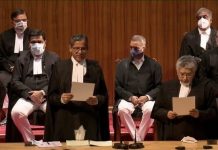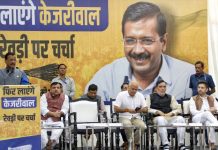 Generally, isolated instances do not rise to the level of severe or pervasive needed to establish the gravity of the issue. If, however, it’s widespread, it may suffice to state a claim. It’s true that the tenure of the Narendra Modi dispensation to date managed to avoid mega corruption scandals, but it’s also true that it failed to take corruption and bribery issues head-on creating proper anti-corruption mood or network. Let’s consider two specific examples and leave out routine corruption and bribery cases for the time being.
Generally, isolated instances do not rise to the level of severe or pervasive needed to establish the gravity of the issue. If, however, it’s widespread, it may suffice to state a claim. It’s true that the tenure of the Narendra Modi dispensation to date managed to avoid mega corruption scandals, but it’s also true that it failed to take corruption and bribery issues head-on creating proper anti-corruption mood or network. Let’s consider two specific examples and leave out routine corruption and bribery cases for the time being.
Cash-for-vote case: According to a recent report, after losing in the gram panchayat elections in Telangana’s Suryapet district on January 25, a candidate’s husband asked people to return cash paid for vote. The spouse apparently gave every voter 800, along with liquor as per prevalent ‘cash per voter’ tradition that ranged from 800 to 1, 500.
Election campaign funding mechanism: The Mahatma Gandhi National Rural Employment Guarantee Scheme (MGNREGS), aimed at easing rural poverty, smacked of alleged corruption time and again. Upasak Das and Diego Mairano in their article ‘Post-clientelistic initiatives in a patronage democracy: The distributive politics of India’s MGNREGA’ published in World Development, explain that while there is little evidence to prove that elected politicians use MGNREGS to buy votes directly, the ruling party does award more contracts to a select network of contractors, who in turn fund the election campaign of those politicians.
According to Transparency International, India ranked 78 out of 180 countries in Corruption Perception Index 2018 scoring 41 out of 100. The score was 38 in 2015 and 40 in both 2016 and 2017.
There is little doubt that money and greed are powerful forces that become corrupting influences on people and their environment. Interestingly, corruption has been a major issue in the country for decades and it has been taken up by almost all the political parties in their election manifestos promising to eradicate corruption. And, it’s primarily because corruption has a disproportionate impact on the poor and most vulnerable, increasing costs and reducing access to various services. Therefore, in a country rife with corruption the issue of eliminating corruption sells.
Greed, and not the willingness to return the favour, is the main reason people give in to bribery, according to Researchers at Carnegie Mellon University (CMU) in the US. The study carried out in several settings, including India suggests that when incentives are dependent on choices, people accept and reward bribes.
Online National Survey: key findings
A few months back LocalCircles in collaboration with Transparency International India conducted an Online National Survey to find out the level of corruption in the country and check the citizen awareness. In its October 2018 report following are the key findings:
56 per cent Indians admit to paying bribes for citizen services as most states failed to put redressal mechanisms in place
91 per cent unaware about their state anti-corruption helpline
Cash remains the primary mode for bribery
Only 13 per cent of the surveyed citizens paid a bribe to government offices which had CCTVs installed
An increase of 11 per cent in bribery from 2017 to 2018
Top 3 corruption prone departments are property registration, police and municipal corporations
Matter-of-factly, corruption has always been a part of human nature and will continue to contaminate society at varying levels, but, the silver lining is that by and large people now are optimistic about government’s any effort that seeks to combat corruption and bribery.
Sadly enough, often, grandiose statements by the policy makers about the importance of anti-corruption measures do not translate into commitment at government level to tackle the institutional problems that sustain corruption.
This world is not, and can never be, ideal; but, as some say parliamentary democracy is no guarantee against corruption, but it is the only one that has a chance of vanquishing it. And, it’s another matter that India never had a transformational leader like Singapore’s Lee Kuan Yew to stamp out institutionalised corruption.
Singapore, granted independence in 1965 was beset by corruption but when Lee Kuan Yew became prime minister, he pledged to rid Singapore of graft. And, by the time Lee stepped down as Prime Minister, in 1990, Singapore had gone from being one of the more corrupt countries on the planet to one of the least.
In essence, therefore, the key question now is not whether combating corruption and bribery is important—but how can we effectively combat it? In other words, what our country needs most to achieve considerable successes in the fights against corruption. The short answer is: unwavering commitment.
Uncovering corruption systems and punishing those involved is essential, but not enough. The country needs to implement medium and long-term measures that demonstrate the country’s serious commitment to eliminate the structural causes of corruption.
Silvia Saccardo, an assistant professor at CMU and a key member of the research team had once said, “Our results suggest that policy interventions that focus on increasing the moral costs of distortion and limit the scope for self-serving biases may provide a successful way to reduce the effectiveness of bribes”.
letters@tehelka.com













